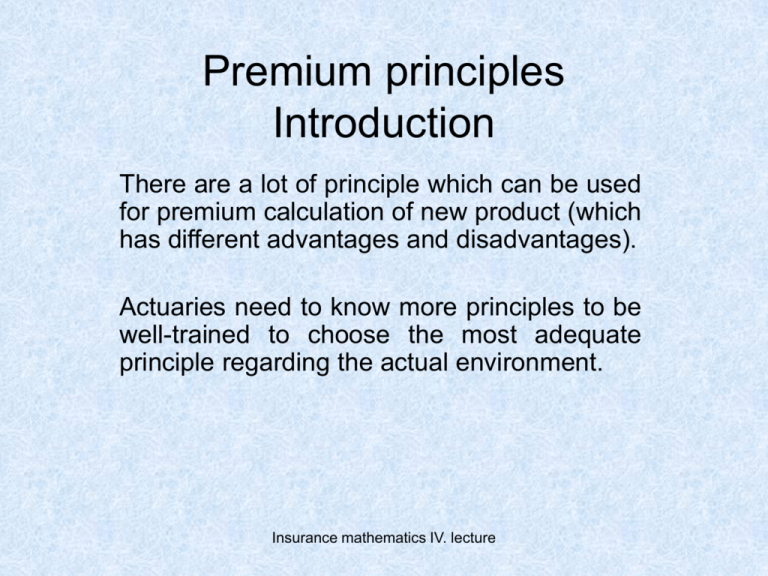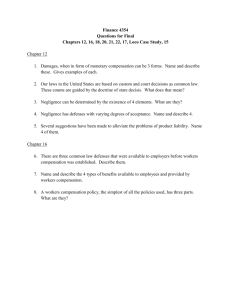Definition
advertisement

Premium principles Introduction There are a lot of principle which can be used for premium calculation of new product (which has different advantages and disadvantages). Actuaries need to know more principles to be well-trained to choose the most adequate principle regarding the actual environment. Insurance mathematics IV. lecture Premium principles Insurance mathematics IV. lecture Premium principles Insurance mathematics IV. lecture Premium principles Classical principles I. Definition: Π is expected value premium principle with λ parameter, if Insurance mathematics IV. lecture Premium principles Classical principles II. Insurance mathematics IV. lecture Premium principles Classical principles III. Proof: At first we suppose that Π is expected value principle. Then Π ξ𝑛 = (1 + λ) ∙ 𝐸(𝜉𝑛 ) and Π ξ = 1 + λ ∙ 𝐸 ξ . Therefore lim Π ξ𝑛 − ξ = lim (1 + λ) ∙ 𝐸 ξ𝑛 − ξ = 0, which proves (i) 𝑛→∞ 𝑛→∞ ii) Π δ𝑐 = 1 + λ ∙ 𝐸 δ𝑐 = 1 + λ ∙ 𝑐 iii) Π 𝑡𝑄 + 1 − 𝑡 𝑆 = 1 + λ ∙ 𝐸 𝑡𝑄 + 1 − 𝑡 𝑆 = 𝑡 ∙ 1 + λ ∙ E Q + + 1−𝑡 ∙ 1+λ ∙𝐸 𝑆 =𝑡 ∙Π Q + 1−𝑡 ∙Π 𝑆 Insurance mathematics IV. lecture Premium principles Classical principles IV. Proof (continued): Insurance mathematics IV. lecture Premium principles Classical principles V. Proof (continued): Let ξ variate which has infinite expected value. Then based on (iii) we get: Because of monotone convergence theorem It means that Π is expected value premium principle. Q.e.d. Insurance mathematics IV. lecture Premium principles Classical principles VI. Definition: Π is maximal loss premium principle with p parameter, if Remark: The huge risk is hazardous, this principle punishes that. Definition: Π is quantile premium principle with ε and p parameters, if Insurance mathematics IV. lecture Premium principles Classical principles VII. Insurance mathematics IV. lecture Premium principles Classical principles VIII. Proof of lemma: (E ξ 𝐴 − 𝐸 ξ )2 = ( Ω ≤( Ω χ𝐴 ∙ ξ𝑑𝑃 − 𝑃(𝐴) χ𝐴 ∙ 𝜉 − 𝐸 ξ 𝑑𝑃 − 𝑃 𝐴 2 ξ𝑑𝑃) ≤ Ω 2 2 (𝜉 − 𝐸 ξ )𝑑𝑃) = ( Ω Ω Insurance mathematics IV. lecture χ𝐴 ( − 1) ∙ (𝜉 − 𝐸 ξ )𝑑𝑃) ≤ 𝑃 𝐴 Premium principles Classical principles IX. Proof of statement: Let Π ξ = 𝑝𝐸 ξ + 1 − 𝑝 𝑟𝜀 ≥ 𝑝𝐸 ξ + 1 − 𝑝 𝐸 ξ ξ < 𝑟𝜀 = 𝐸 ξ , because Insurance mathematics IV. lecture Premium principles Classical principles X. Q.e.d. Definition: Π is variance premium principle with β parameter, if Insurance mathematics IV. lecture Premium principles Classical principles XI. Definition: Π is standard deviation premium principle with β parameter, if Remark: The above two principles punish the difference with expected value. But there is a question why we punish if the risk less then expected value. That is why it is more useable the next principle for which it is necessary the following definition. Insurance mathematics IV. lecture Premium principles Classical principles XII. Definition: Let semi-variance of ξ the next formula: Definition: Π is semi-variance premium principle with β parameter, if Insurance mathematics IV. lecture Premium principles Classical principles XIII. Insurance mathematics IV. lecture Premium principles Classical principles XIV. Proof (continued): We use the earlier inequalities for these variate: It follows: Insurance mathematics IV. lecture Premium principles Classical principles XV. Let ξ1 the next variate: 𝜎2 𝜎2 𝜇2 𝑃 ξ1 = 0 = 2 ; 𝑃 ξ1 = 𝜇 + = 2 𝜎 + 𝜇2 𝜇 𝜎 + 𝜇2 Insurance mathematics IV. lecture Premium principles Mathematical properties of premium principles I. Definition: ( ) is risk-loading, if ( ) E( ) H Loading for risk is desirable because one generally requires a premium rule to charge at least the expected payout of the risk ξ, namely E(ξ), in exchange for insuring the risk. Otherwise, the insurer will lose money on average. Insurance mathematics IV. lecture Premium principles Mathematical properties of premium principles II. Definition: ( ) is no unjustified risk-loading, if a risk is equal c 0 almost everywhere then ( ) c. If we know for certain (with probability 1) that the insurance payout is c, then we have no reason to charge a risk loading because there is no uncertainty as to the payout. Definition: ( ) is no rip-off, if ( ) sup( x : P( x) 0) H Insured will not pay more than its maximum risk (with positive probability). Definition: ( ) has translation invariance property, if ( a) ( ) a H , a 0 If we increase a risk ξ by a fixed amount a, then this property states that the premium for ξ + a should be the premium for ξ increased by that fixed amount a. Insurance mathematics IV. lecture Premium principles Mathematical properties of premium principles III. Definition: ( ) has scale invariance property, if (b ) b ( ) H , b 0 This property essentially states that the premium for doubling a risk is twice the premium of the single risk. One usually uses a no arbitrage argument to justify this rule. Indeed, if the premium for 2ξ were greater than twice the premium of ξ, then one could buy insurance for 2 ξ by buying insurance for ξ with two different insurers, or with the same insurer under two policies. Similarly, if the premium for 2 ξ were less than twice the premium of ξ, then one could buy insurance for 2 ξ, sell insurance on ξ and ξ separately, and thereby make an arbitrage profit. Scale invariance might not be reasonable if the risk ξ is large and the insurer (or insurance market) experiences surplus constraints. In that case, we might expect the premium for 2 ξ to be greater than twice the premium of ξ. Insurance mathematics IV. lecture Premium principles Mathematical properties of premium principles IV. Statement: If Π(ξ) has scale invariance and translation invariance properties then Π(ξ) is no unjustified risk-loading. Proof: We assume that ξ ≡ 𝑐. Then (because of scale invariance property): Π 0 =Π 0∙ξ = 0∙Π ξ =0 Finally we get: Π ξ =Π c =Π 0+c =Π 0 +𝑐 =0+𝑐 =𝑐 Insurance mathematics IV. lecture Premium principles Mathematical properties of premium principles V. Definition: Π(ξ) is additive, if Π ξ + η = Π ξ + Π η ∀ξ, η ∈ 𝐻Π Additivity is a stronger form of scale invariance. One can use a similar noarbitrage argument to justify the additivity property. Definition: Π(ξ) is sub-additive, if Π ξ + η ≤ Π ξ + Π η ∀ξ, η ∈ 𝐻Π One can argue that subadditivity is a reasonable property because the noarbitrage argument works well to ensure that the premium for the sum of two risks is not greater than the sum of the individual premiums; otherwise, the buyer of insurance would simply insure the two risks separately. However, the no-arbitrage argument that asserts that Π ξ + η cannot be less than Π ξ + Π η fails because it is generally not possible for the buyer of insurance to sell insurance for the two risks separately. Insurance mathematics IV. lecture Premium principles Mathematical properties of premium principles VI. Definition: Π(ξ) is super-additive, if Π ξ + η ≥ Π ξ + Π η ∀ξ, η ∈ 𝐻Π Super-additivity might be a reasonable property of a premium principle if there are surplus constraints that require that an insurer charge a greater risk load for insuring larger risks. For example, we might observe in the market that Π(2 ∙ ξ) ≥ 2 ∙ Π(ξ) because of such surplus constraints. Note that both sub-additivity and super-additivity properties can be weakened by requiring only Π(𝑏 ∙ ξ) ≤ 𝑏 ∙ Π(ξ) or Π(𝑏 ∙ ξ) ≥ 𝑏 ∙ Π(ξ) for b > 0, respectively. Next, we weaken the additivity property by requiring additivity only for certain insurance risks. Definition: Π(ξ) is additive for independent risks, if Π ξ+η =Π ξ +Π η ∀ξ, η independent risks Some actuaries might feel that additivity property is too strong and that the no-arbitrage argument only applies to risks that are independent. They, thereby, avoid the problem of surplus constraints for dependent risks. Insurance mathematics IV. lecture Premium principles Mathematical properties of premium principles VII. Definition: Π(ξ) is monoton, if ξ 𝜔 ≥ η 𝜔 ∀𝜔 ∈ Ω → Π(ξ) ≥ Π(η) Although the above properties are (more or less) natural the earlier reviewed principles do not satisfy these properties in each case. The next table shows a short summary which principle satisfies which property: Insurance mathematics IV. lecture Premium principles Mathematical properties of premium principles VIII. Property/ principle Expected Value Variance Standard Deviation Independent Y Y Y Risk loading Y Y Y Not unjustified N Y Y No rip-off N N N Translation inv. N Y Y Scale inv. Y N Y Additivity Y N N Sub-additivity Y N N Super-additivity Y N N Monotone Y N N Insurance mathematics IV. lecture Premium principles Mathematical properties of premium principles IX. As earlier it can be seen that there is no one useable method for each case, but actuaries has to calculate prudential. What is the most useful process to calculate premium? At first we have to make a list according to the given problem which properties has to be satisfied ( it can be used two categories: „must” and „nice to have” categories). Checking which known principle satisfies the necessary properties. If one exists we find the adequate method. If no one exists we have to define a new principle. In this case there is necessary to check each necessary requirement for the problem and the natural requirements also. Insurance mathematics IV. lecture Gross premium Premium elements: - net premium (due to risk) - costs (commission, maintenance cost, claims handling cost) - safety plus - profit rate GP=NP+C+SP+PR Insurance mathematics IV. lecture






